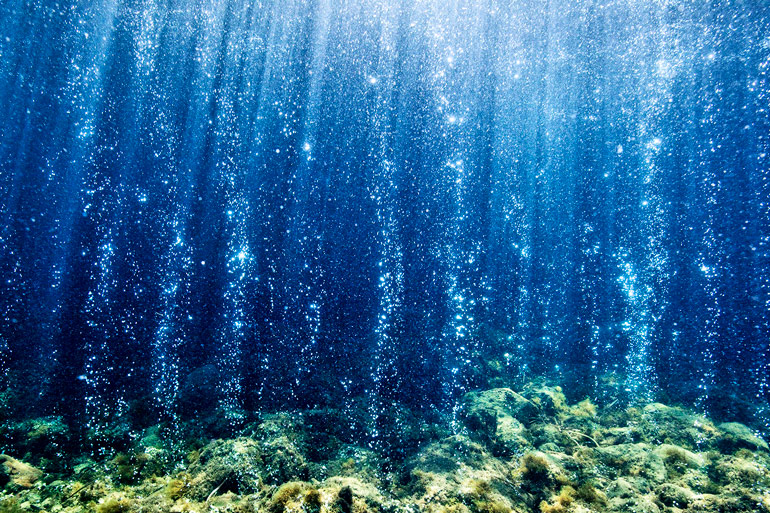Streams of gas-filled volcanic bubbles rising up to the surface off the rocky cliffs of Ischia, Italy are making the seawater acidic and radically changing life around them in the process.
Researchers studying species living near these gassy vents are learning what it takes to survive in acidic waters—and getting a glimpse of what future oceans will look like if the acidification continues.
Their findings, which appear in Nature Communications, suggest ocean acidification driven by human-caused carbon dioxide emissions could have a larger impact than previously thought.

“When an organism’s environment becomes more acidic, it can dramatically impact not only that species, but the overall ecosystem’s resilience, function, and stability,” says coauthor Fiorenza Micheli, a professor of biology at Stanford University. “These transformations ultimately impact people, especially our food chains.”
Real-life lab
Most ocean acidification studies take place in laboratories, which makes it impossible to assess how whole ecosystems that include multiple, interacting species are affected. The real-life laboratory provided researchers an opportunity to examine dozens of species, including sea urchins and marine snails, that live in areas of different acidity along Ischia’s volcanic carbon dioxide vents.
In addition to studying how species diversity changed with acidification, they analyzed species traits, such as diet and growth, that influence how well the ecosystem performs. For example, sea snails were smaller in more acidic water, as their shells take longer to grow and are thinner and more brittle.
These harmful effects on sea snails, a key food for animals higher up in the food chain, may affect fish populations.
Overall, researchers found that the active venting zones with the most acidic waters were home to not only the least number of species, but also the lowest amounts of “functional diversity”—the range of ecosystem-support services or roles that each species can provide.
“Studying the natural carbon dioxide vents in Ischia allowed us to unravel which traits from different species, like snail shell strength, were more vulnerable to ocean acidification. These results illuminate how oceans will function under different acidification scenarios in the future,” says lead author Nuria Teixidó, a marine biologist from Stazione Zoologica Anton Dohrn in Italy, who was a visiting researcher at Stanford during the research.
Ocean instability
Acidification in the waters of Ischia displaced long-lived species, such as corals, that form habitat for other species—a process already often witnessed on reefs across the world. The researchers also found that high levels of carbon dioxide and more acidity favored species with short life spans and fast turnover as they are the only species that can resist these environmental conditions. This change could lead to further diversity loss and instability in the oceans, as biodiversity tends to increase an ecosystem’s stability.
Localized case studies such as Ischia can shed light on how future global environmental conditions may affect ocean life. Beyond losing biodiversity, ocean acidification will threaten food security for millions of people who depend on seafood, along with tourism and other ocean-related economies.
“The effects of ocean acidification on whole ecosystems and their functioning are still poorly understood,” Micheli says. “In Ischia, we have gained new insights into what future oceans will look like and what key services, like food production and coastal production, will be lost when there is more carbon dioxide in the water.”
The National Geographic Society, the Total Foundation, a Maire Curie Cofund, and a Marie Sklodowska-Curie Global Fellowship funded the work.
Source: Stanford University



